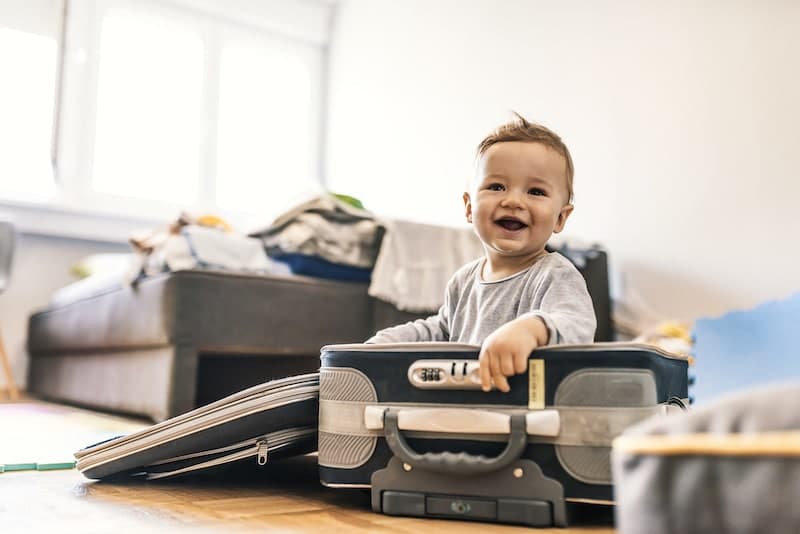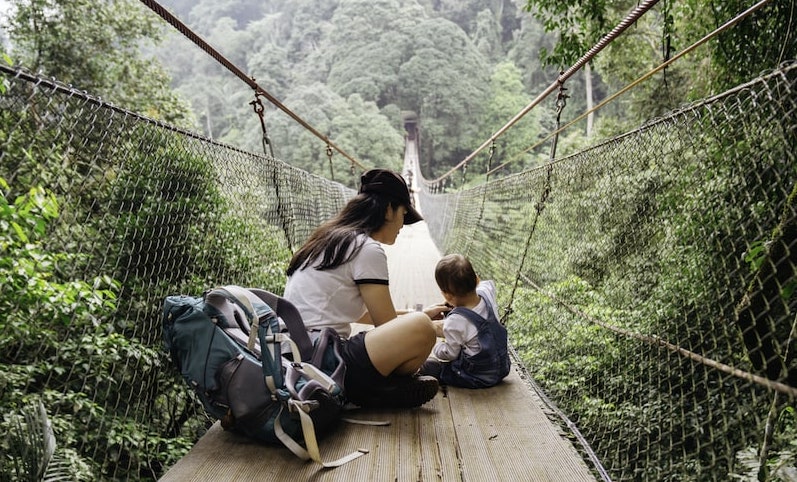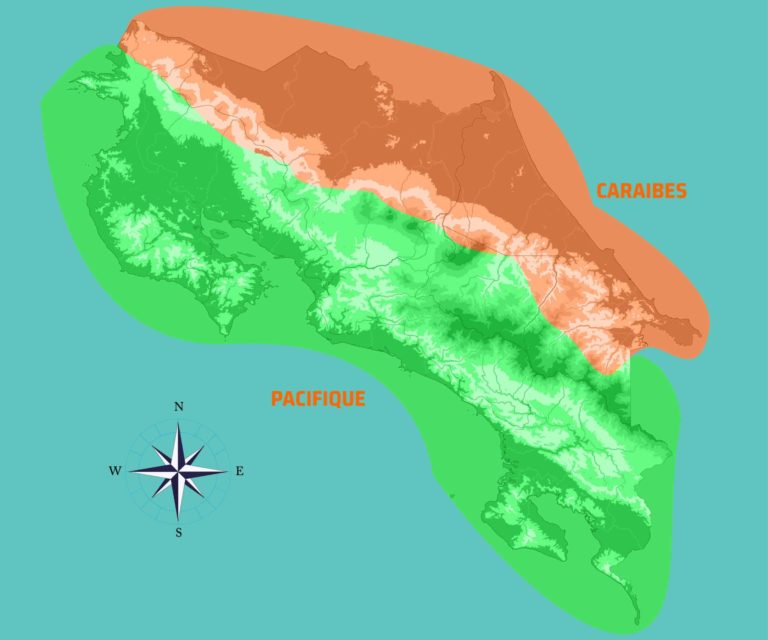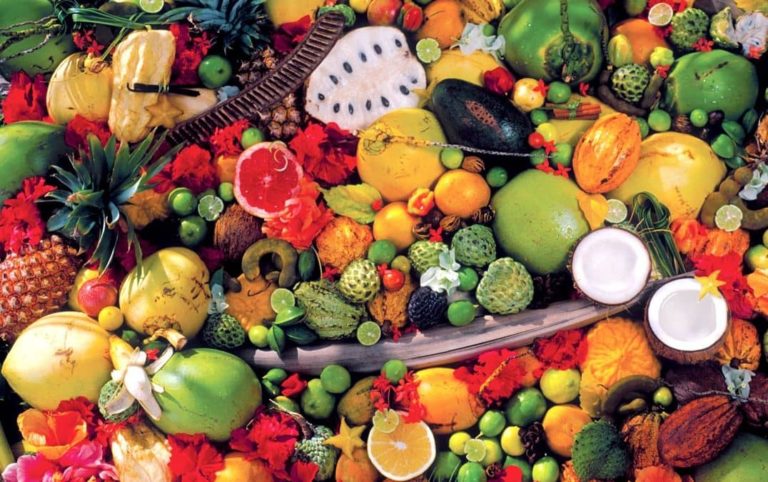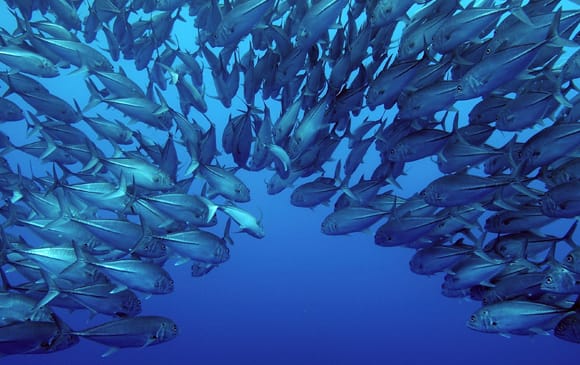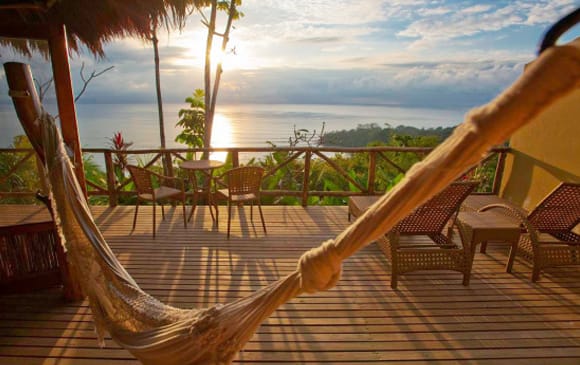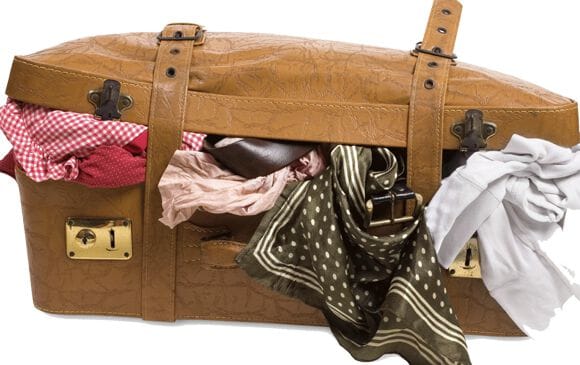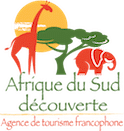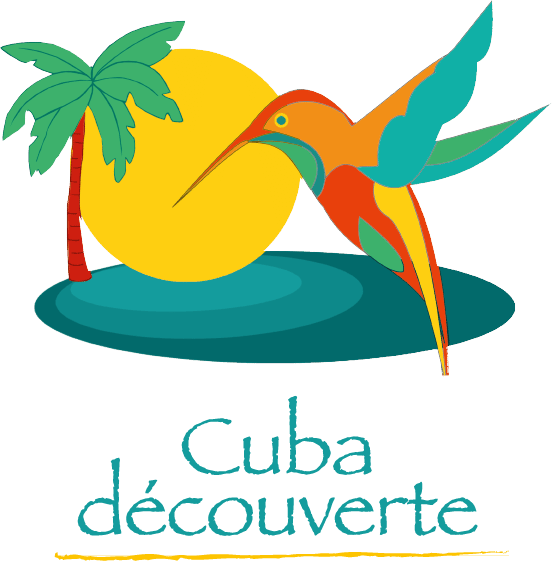Traveling to Costa Rica with a baby can be a wonderful experience, as the country offers a wide variety of outdoor activities, stunning landscapes, and opportunities to discover nature. Animals, national parks, beaches, volcanoes—so many things to explore as a family. Children are very receptive to their surroundings, and Costa Rica is generally well-appreciated even by the youngest travelers. Costa Rica Découverte adapts itineraries to ensure the journey is smooth and hassle-free.
However, it requires careful planning to ensure the safety and comfort of your child.
Here are some tips to help you prepare for your trip to Costa Rica with a baby.
Preparing your family trip to Costa Rica
First and foremost, traveling with a young child requires a minimum of precaution. The child should be in good health and up to date with vaccinations. Prepare a first-aid kit with bandages, fever and pain medication, diarrhea remedies, mosquito repellent, a thermometer, etc. Consult your pediatrician for more information.
Vaccination
Costa Rica is a safe country in terms of hygiene, but before traveling, it is recommended to check necessary vaccines and medications. Traditional vaccines such as tetanus, DTP polio, whooping cough, and measles are highly recommended. If you are staying in certain countries before arriving in Costa Rica, you will need a yellow fever vaccination (see the list).
Bring a good mosquito repellent—or better yet, buy one locally—as some regions like Limon have occasional Dengue outbreaks. The Dengue vaccine is not recommended for those who have never been infected before.
Traveler’s diarrhea, commonly known as “Tourista,” is one of the most frequent travel-related illnesses. To avoid it, refrain from eating street food, wash your hands and your child’s hands regularly, and avoid tap water—even though it is potable in most areas. Also, avoid ice cubes in drinks.
If symptoms appear, seek medical advice promptly and stay hydrated to prevent dehydration. Fortunately, this is rare, and the country has an excellent healthcare network, including clinics, pharmacies, and hospitals nationwide.
Passports
The requirements for entering Costa Rica are simple. If you are staying for less than 180 days, no visa is required for European Union citizens or Swiss nationals.
Your passport must be valid for at least 24 hours after your return. However, we recommend renewing it in advance if it is close to expiration, as flight diversions to neighboring countries like the USA, Panama, or Colombia could cause issues with local authorities. A passport is required for children of all ages.
French law states that minors traveling with one or both parents do not need an exit authorization. However, if your child does not share your last name, carrying a birth certificate is recommended to avoid any complications.
If you have a layover in the USA or Canada, be sure to apply for your ESTA Visa for the USA and eTA for Canada—even for babies.
Flying with a Baby
If we had one piece of advice, it would be to choose the most direct flights possible. A direct flight is ideal; one layover is reasonable, but two or more can become exhausting and stressful. While direct flights are sometimes more expensive, they offer the best conditions for your little one. Until the age of two, children can travel on their parents’ lap. Beyond that, a separate seat is mandatory.
What outfits and accessories for baby?
For the flight, bring enough food to feed and change baby, as well as mom and dad, for the entire flight, and even a little more in case of delays or untimely changes. Lotions, creams, bottle water, powdered milk, baby food… Everything you need can stay with you in the cabin, with no restrictions on liquids. However, on-board personnel can provide you with water if you need it.
The ideal suitcase for your little one:
• YOUR child’s comforter, pacifiers or any other toy he’s used to having. This will help reassure him, as travel can be a little unsettling for our little ones,
• Lightweight clothing,
• Light, long pants
• Long-sleeved T-shirts to protect against mosquitoes at the end of the day,
• Lycra for protection against the sun,
• A cap with a neck flap,
• Sunglasses, as it’s very hot here,
• A sweater and/or sweatshirt,
• Rain gear,
• Water bottle, baby bottles,
• Up-to-date health record…
Some would say that a stroller would just be a burden. But if, as we recommend, you rent a car, it will come in handy in restaurants, airports and impromptu naps.
Car seats are provided free of charge by our rental companies.
For hiking, a backpack so you can keep your camera in hand 😉
Numerous specialized websites give you tips on travelling with baby.
What’s the budget for a family trip?
Costa Rica is a developed country in Central America with a reputation as a somewhat expensive destination. This varies according to each person’s choices, and we’ll give you an estimate below, based on the different criteria and categories of stay envisaged.
Small budgets
If you travel in a hostel with shared rooms and bathrooms, using a public bus and doing only free or low-cost activities, you can estimate a stay of around 3,500 euros for 2 people, including round-trip tickets Paris/San José (1,000 euros per person) for two weeks in Costa Rica.
This option is not recommended for very young children.
Average budgets
Do you like a little more comfort, do you want private bathrooms, do you want to be independent with a rental car? This is certainly the best way to discover the country. Alternating between basic hotels and some slightly superior ones, and renting a standard vehicle, the flight + stay budget is $4,900 for two people for two weeks.
Higher budgets
Are you looking for a comfortable vacation, a top-class hotel, a 4×4 car rental and plenty of activities, even if you have to pay for them? The 14-day trip in a 3/4-star hotel, with a 4×4 that will take you wherever you want to go, will cost you around 8900 euros with flights from Paris.
Luxury budgets
This travel category is for those who love luxury, service and personalized attention. It’s also the category without limits. You’ll find plenty of luxury lodges and dream villas for an exceptional stay. Beware, however, that many hotels in this category are reserved for adults only. What’s more, these are very expensive hotels, so it’s best to book well in advance. It’s possible to indulge yourself for as little as 12,000 euros for two people and two dream weeks in Costa Rica.
All these budgets are indicative only, and we adapt our stays to your wishes, your budget and your particular requests. Don’t hesitate to ask us for a quote to find out how much you need to budget for your ideal trip.
What criteria should you take into account when choosing a Costa Rica family tour?
To ensure that your trip goes as smoothly as possible, there are a few essential criteria to bear in mind.
Travel structure
- The duration of the flight is often tiring and baby, like mom and dad, has a bit of trouble settling down.
- The length of your stay is another factor to consider. Long-haul trips are generally tiring, and it would be a shame to bring a baby for just a few days. Take your time, and at least two weeks, to get the most out of your trip without making everyone tired and irritated. If you don’t have enough time off, don’t go so far.
- Not all stages are suitable for toddlers. For families, we recommend the following: San José, Arenal, Monteverde, Cahuita, Puerto Viejo, Samara, Manuel Antonio, Uvita, San Gerardo de Dota. As far as Corcovado is concerned, the two resorts of San Pedrillo and La Sirena are not suitable for babies. Arrival by boat can be a bit tricky, with intense humid heat and few rest areas.
The climat
- Costa Rica’s hot, humid climate is an important criterion, especially if you arrive in January or February, the height of winter in Europe. You’ll need to keep well hydrated and rest during the hottest hours of the day.
Insurance
- Travel insurance is essential. Indeed, many families don’t protect themselves, and a minor accident, boo-boo or illness can be very costly, because as a tourist, you’ll be directed straight to the private clinics. A simple operation very quickly costs 5,000 to 6,000 euros, and you’ll have to make an advance payment. When you return home, your social security system will only cover up to its ceiling, with a lot of red tape. We recommend that you take out insurance when you buy your tickets.
The seasons
- A recurring question when planning a trip to Costa Rica is what’s the best time of year to travel. While many tourists only want good weather and come in January/February or March, this is also the hottest and most touristic period. Parks are full and walks can be intense. By the sea, on the beach, it’s not uncommon to reach 35 or even 40 degrees in the shade. This isn’t necessarily the most pleasant thing to do with a toddler. We recommend the months of May, June, July, August and November. The nights are cooler, and baby will be grateful. The climate in the tropics is very different, and this aspect is essential to take into account.
Managing jet lag: our advice
As mentioned above, Costa Rica is a long way away. In winter, we have a 7:00 time difference from France and Europe in general, and in summer 8:00. Dealing with the time difference when traveling with a baby can be a challenge, but good planning will help your child adapt more easily.
- Make sure your baby stays well hydrated during the flight by giving him water or breast milk/formula. Flights are dehydrating.
- Avoid over-stimulation: maintain a calm, peaceful environment, especially at night, to help your baby fall asleep more easily.
- As soon as you arrive in Costa Rica, try to adapt to local time as quickly as possible. Expose your baby to daylight to help regulate his biological clock, and put him to bed early.
- Take care of your own sleep. Well-rested parents are better able to look after their baby during the journey.
- If you have a bedtime routine for your baby at home, try to recreate it during the trip. This will signal to your baby that it’s time to go to sleep.
- Avoid long car journeys the day after or two days after your arrival.
What food to feed your baby in Costa Rica?
For meals, if your child is not yet a solid eater, we recommend that you pack a few ready-to-eat salted meals, as these are hard to find in supermarkets.
On the other hand, you’ll find everything you need for diapers, baby formula, sweetened baby food, compotes and yoghurt in even the most remote grocery stores. So don’t go overboard…
In restaurants, don’t hesitate to ask waiters to make you homemade mashed potatoes, porridge and minced meat or fish. We also recommend that you take with you :
- cookies,
- ready-to-eat savoury meals,
- drinking bottles,
- and of course, ALWAYS take mineral water with you.
You can also introduce baby to new tastes. Take advantage of this trip to introduce him to exotic flavors. This is the realm of bananas, pineapple, avocado, mango and, of course, AGUA DE PIPA, coconut water. Make him suck the flesh of the coconut and he’ll thank you for it. Ice creams are quite common, and specialist stores like POP’S are popular even with toddlers. Most restaurants offer baby seats.
Which mode of transport is best for a trip to Costa Rica with baby?
As we mentioned earlier, the best way to travel with a baby is by car. Renting a car means you can enjoy the country and adapt to your child at all times. You can stop whenever you like, change him, stretch his legs and always have his toys, cuddly toy, cookies or bottle close at hand.
Independence is the secret. No impossible schedules to keep, no other people to wait on or fetch. In short, true freedom. You can punctuate your journeys with relaxing breaks and short visits, so you don’t get stressed out.
With a rental car, you can leave accessories such as strollers, car seats and baby equipment in the trunk at all times, and have them with you all the time.
With a self-drive tour, you can visit a national park, a volcano or a beach as and when you like, with no time constraints.
What type of accommodation should I choose to stay in Costa Rica with my baby?
For itinerant stays, the best option is to stay in a hotel. You don’t need to make any special arrangements. We reserve the best rooms for you, with a bed adapted to your child’s needs. Breakfast is taken at the hotel, so you can start the day with a full belly. It’s undoubtedly the most comfortable.
Many accommodations offer relaxation areas around the pool or a lovely viewpoint. Hotels with large properties usually have trails that allow you to explore the surroundings without having to move around too much. Lodges or cabinas are particularly attentive to families with young children, and local children will often come to say hello to your baby.
Baby’s rhythm
Your baby’s rhythm will set the tempo for the trip. We recommend that you keep in mind that a little space is essential. At Costa Rica découverte, we prefer hotels with bungalows or terraces. In fact, during your child’s nap, having a space of your own, a little out of the way, will enable you to enjoy this moment while leaving baby in peace and quiet.
Some hotels also offer connected rooms. In other words, large rooms separated by a door, much like at home. So you can keep your privacy while staying close to your little one.
The restaurants
A point often overlooked, but in our opinion essential, is the proximity of restaurants. Breakfast can be taken at the hotel, lunch can be taken anywhere, depending on the day’s program, but in the evening, your child is likely to be tired. Taking the car out to eat can quickly become a real chore. A hotel with a restaurant means you can have dinner quickly, but more importantly, you can let your baby sleep in the stroller during the meal. All you have to do is slide him into bed on the way back, and he’ll have no trouble at all. He’ll be calm and serene, and so will you.
Ideal family activities
We’ve gone over the preparations, the plane journey, the formalities, the accommodation and the itinerary with baby. Now let’s move on to the crucial point: activities. It’s important to realize that many things simply won’t be possible. But what is actually possible in Costa Rica?
Here are the possible activities by age group. An overview of the immeasurable variety the country has to offer its visitors.
From 1 month to 1 year
- You can enjoy the beaches at your leisure. Costa Rica has some wonderful family-friendly ones. You can relax on the sand, have a picnic and let your little one play in the soft sand and shade of the mangroves. The most child-friendly are, in our opinion, on the Caribbean coast: playa Blanca, playa Cocles, playa Chiquita, playa Cahuita, and on the Pacific coast, playa Mina, playa Pelada, playa San Juanillo, playa Samara, Punta Islita, playa Coyote, playa Buenavista, playa Hermosa (Uvita). Here’s a short article on the most beautiful in Costa Rica.
- Wildlife watching: Costa Rica is famous for its biodiversity. You can go on excursions to observe wildlife, including monkeys, exotic birds, sloths and turtles. Many reserves and parks are particularly suitable for the very young.
- Discovering the botanical gardens offers a peaceful and educational experience for families. Your baby can explore plants, flowers and nature in a safe environment.
- Boat trips: boat trips along Costa Rica’s rivers and canals are an excellent opportunity to see the flora and fauna, while offering a safe environment for toddlers. Floating boats in particular are well suited to this age group.
- Relaxing in thermal springs: Costa Rica is famous for its natural thermal waters. Some offer shallow pools and relaxation areas for families. Little ones are welcome.
- Discover the local culture: with your little one, visit local markets, attend traditional festivals and discover Costa Rican culture. The locals are generally very family-friendly, and your little one will soon be the center of attention.
- Wildlife sanctuaries: Costa Rica is home to many wildlife sanctuaries where you can see exotic animals up close. These places are often the perfect place for wildlife and children to interact. However, you won’t be able to touch or stroke them.
1 to 2 years
You can do everything that has been said above, of course, but also :
- The suspension bridges are great walks to take, even with a baby. A truly colorful discovery of nature.
- Discover Costa Rican rural life by visiting farms where toddlers can interact with farm animals.
- Boat trips on rivers or along the coast allow little ones to enjoy the experience in complete safety.
- Visits to national parks such as Arenal, Tenorio, Manuel Antonio, Rincon de la Vieja and Cahuita. These parks have short, easy trails, so that children can follow them without worry.
From 2 to 5 years
This is the age of discovery. Young children are wide-eyed and curious by nature.
- Toddlers aged 2 to 5 can take part in boat trips to snorkel in shallow waters.
- Some cooking schools offer child-friendly courses where children can help prepare traditional dishes..
- Some of the canopies are also accessible to children.
- Horseback riding with Mom and Dad and their guide is a great way to discover new things.
From age 5 upwards, most activities are possible, apart from scuba diving, canyoning and rafting. Costa Rica offers a multitude of sports, and it’s impossible not to find something to suit your taste.
Here’s an overview of the essentials for a trip with baby to Costa Rica. Here are a few tours that can be adapted to families.
Découvrez d’autres articles de blog
Pourquoi voyager avec nous ?

Une réputation sans faille depuis 2008

Un seul interlocuteur en français

Notre présence toute l’année sur le terrain

Notre expertise pour une offre sur mesure

